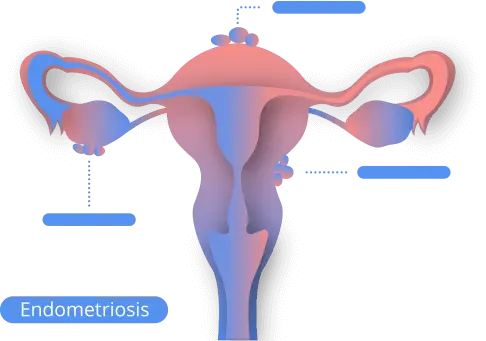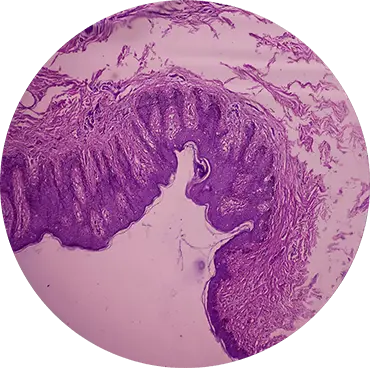Endometriosis and infertility
Problems with a female’s uterine lining due to disorders like endometriosis is one of the many potential causes of infertility. But it’s also incredibly common. In fact, 25% to 50% of women who are infertile have been diagnosed with endometriosis, and 30% to 50% of women who have endometriosis are infertile.
Read on to learn more about endometriosis, including how it’s connected to infertility and how Fertility Cloud can help.
What is endometriosis?

Endometriosis is a disorder that forms tissue in places where it shouldn’t be, such as in the ovaries and fallopian tubes. The tissue is similar to the tissue found inside the uterus, called the endometrium. Areas where the endometrium-like tissue is formed are called endometrial implants. They can result in menstruation issues, as the tissue thickens and breaks down the same way the interior uterine lining does. But the blood gets trapped as it doesn’t have a way to exit the body.
While endometriosis affects the lining of a female’s pelvis, it can also affect the fallopian tubes and ovaries. When the ovaries are affected by this condition, it can result in cysts called endometriomas. It can also cause the organs and pelvic tissue to adhere to one another when the surrounding tissue becomes irritated and forms scar tissue.
Endometriosis can vary in severity and can be categorized in one of four stages, ranging from minimal to severe. The stage classification is based on aspects including:
- Depth, location and severity of endometrial implants.
- Presence of abrasions.
- Number and size of cysts.
How common is endometriosis?
If you’ve been diagnosed with endometriosis, you are not alone. It affects about 190 million people around the world, making up 10% of the global population.
Endometriosis can start anywhere between a female’s first period and menopause, but the diagnosis is most common in their teenage years or in their 20s. On average, the condition takes seven to nine years to get a diagnosis, as the symptoms can change as time goes on and it doesn’t affect every female in the same way.
Endometriosis symptoms
Pain is the most prevalent symptom of endometriosis, but it doesn't occur in every case. The pain can also manifest in different ways. The pain can be joined by a variety of other potential symptoms as well, especially during menstruation.
Endometriosis symptoms include:
- Painful periods (dysmenorrhea).
- Painful urination and bowel movements.
- Painful sexual intercourse.
- Excessive bleeding between periods (intermenstrual bleeding).
- Infertility.

How endometriosis is connected to infertility
Tissue lining the outside of the uterus can make it difficult to conceive. For instance, endometriosis can block the fallopian tubes, and as a result, the eggs are unable to travel to the uterus. Scar tissue can also contribute to the possibility of infertility.
It’s important to note that endometriosis doesn’t automatically cause infertility, since the severity of the condition can vary from person to person as shown by the range of diagnosable stages. Couples with infertility due to mild untreated endometriosis have a monthly conception rate of up to 4.5%.
Potential causes of endometriosis
While there isn’t one definitive reason why females develop endometriosis, there are a few potential causes of the disorder.
Possible causes of endometriosis include:
- Immune system disorder — Problems with your immune disorder can prevent your body from recognizing and getting rid of tissue outside the uterus.
- Peritoneal cell transformation — Cells on the inner side of your abdomen, called peritoneal cells, can become endometrial cells due to hormones or immunity.
- Embryonic cell transformation — It’s possible for hormones like estrogen to turn embryonic cells into endometrial cells during puberty.
- Retrograde menstruation — This refers to menstrual blood going up through the fallopian tubes instead of down through the vagina. It’s possible for the blood to have endometrial cells that can stick to the pelvic walls.
- Surgical scar implantation — Endometrial cells may latch onto a surgical incision after procedures like a hysterectomy or C-section.
Potential risk factors for endometriosis include:
- Short menstrual cycles.
- Heavy menstrual cycles.
- High levels of estrogen.
- Getting your first period young.
- Menopause at an older age.
How Fertility Cloud can help with infertility connected to endometriosis
While there isn’t one definitive reason why females develop endometriosis, there are a few potential causes of the disorder.
Infertility can be frustrating and disheartening on its own, especially if it’s coupled with the physical pain that can stem from endometriosis. But you shouldn’t stop trying, and we’re here to help.
With in-home testing, treatment recommendations and fertility medication sent right to your door, Fertility Cloud can help you with every possible treatment option to increase your chance of conception, even with endometriosis. Your fertility specialist will learn about your endometriosis and how it may be causing infertility to determine the treatment options that may work best for your body.
Potential treatment options that your fertility specialist may recommend for endometriosis include:
- Ovarian stimulation and ovulation induction.
- Trigger shots.
- Home insemination kits
Contact our team by phone today for more information or book an initial appointment online with a fertility specialist.